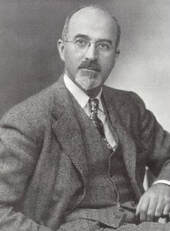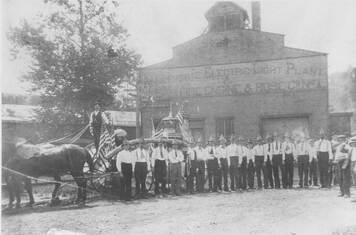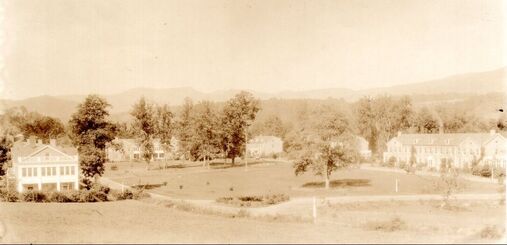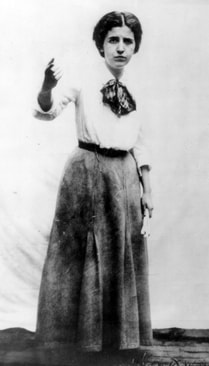Early Queer History of the Greenbrier ValleyBy Sarah Shepherd - Archive Associate “Of course, sex has been all things in all periods…But on the whole, the farm enjoyed sex more, respected it more, and discussed it less…Sex was like groceries…most of the people stored their supplies at home. And county eating is lush and good. I have never understood this much-bruited Puritanism. We were Presbyterians of the deepest dye, running to clergymen and elders and tenders of out-post Sunday Schools. But I do not recall any adults who worried about their immortal souls (the Lord would tend to that) nor about their sexuality; the Lord had already tended to that.” |
| The focus on sodomy meant that women were not arrested as much as men. However, Elizabeth Gurley Flynn, a political radical who was sentenced to two years in the Alderson Federal Women’s Prison in 1951, described lesbianism in the prison in her memoir. She described how “the women walked two-by-two, as directed by the officer. But they chose their own partners and woe betide anyone who tried to cut in on an unmistakable lesbian pair… |
| In the dark of the movies these pairs held hands and kissed passionately, and walking home hung behind the lines, behaving in a lover-like fashion.”[18] While some of these relationships were temporary, other women exchanged rings and called each other husband and wife.[19] Flynn described one woman who grew up in Alderson and both her and her sister were lesbians. She was in a relationship with another woman. Her lover broke it off when she fell in love with a man, but he deserted her when she became pregnant. The two women resumed their relationship and raised the child together. The mother eventually married someone else when their son was five, but the boy kept in touch with his other mother.[20] |
 Walter Freeman
Walter Freeman
In Greenbrier County, there were five known convictions of sodomy. Five men were convicted from 1950 to 1963 with their names and crime posted in the public newspaper, the Greenbrier Independent.[23] At this time, the Greenbrier Independent’s motto was “Nothing Shall be Indifferent to Us Which Advances the Cause of Truth and Morality or Which Concerns the Welfare of the Community in Which We Live.”[24] These men were forcibly outed to their community as all indictments were listed on the front page. West Virginia did not repeal its sodomy law until 1976.[25]
Other Literature on Appalachian and West Virginian Queer History
| Rebecca Baird, Kathryn Staley, and Jeff Mann, “Mountaineer Queer: An Interview with Jeff Mann,” Appalachian Journal, Vol 35. No 1/2 Fall 2007/Winter 2008 Kate Black and Marc A. Rhorer, “Out in the Mountains: Exploring Lesbian and Gay Lives,” Journal of Appalachian Studies Association Vol 7. 1995 Jeff Mann “Stonewall and Matewan: Some Thoughts on Gay Life in Appalachia” in Journal of Appalachian Studies, Vol. 5, No. 2, Fall 1999 Edge: Travels of an Appalachian Leather Bear, Harrington Park Press, 2003 Loving Mountains, Loving Men, Ohio University Press, 2005 “The Mountaineer Queer Ponders His Risk-list,” Appalachian Journal, Vol. 34, No. 3/4 Springs/Summer 2007 Binding the God: Ursine Essays from the Mountain South, Bear Bones Books, 2010 | “Risk, Religion, and Invisibility,” Journal of Appalachian Studies, Vol. 20, No. 2, Fall 2014 Silas House, “Our Secret Places in the Waiting World: or, A Conscious Heart, Continued,” Journal of Appalachian Studies, Vol. 20, No. 2, Fall 2014 Carrie Nobel Kline, Revelations, Huntington, West Virginia, 2001. This was a theatrical presentation about Appalachian resiliency in lesbian, gay, bisexual and transgendered people written and produced by folklorist Carrie Nobel Kline. Read more about the project: https://www.folktalk.org/spoken-histories/glbt-stories/ Her collection of interviews of queer West Virginians are at Marshall University. Bradley Milam, Gay West Virginia: Community Formation and the Forging of a Gay Appalachian Identity, 1963-1979, Dissertation at Yale University, April 2010. |
References
[2] Doug Hylton, “Ronceverte’s story connected with transgendered citizen,” Mountain Messenger, January 23, 2016.
[3] New York, New York, U.S., Extracted Marriage Index, 1866-1937, Maynard Best to Bryna Stacking Hunthall, June 30, 1906, http://ancestry.com.
[4] 1910 U.S. Census, Los Angeles, California, population schedule, p.1, dwelling 18, family 19, Maynard H. Best, digital image, http://ancestry.com.
[5] California, U.S., Death Index, 1905-1939, Dollie Best, death January 1, 1935, http://ancestry.com.
[6] “Fire at Cass,” Pocahontas Times, February 25, 1915.
[7] “Circuit Court,” Pocahontas Times, April 15, 1915.
[8] “The Strange Case of Max Curry,” Pocahontas Times, April 22, 1915.
[9] Marriage of Lillian L. Nethercutt and M. M. Curry, 1909, Vital Research Records-Marriage, West Virginia Department of Arts, Culture, and History, http://www.wvculture.org/vrr/va_mcdetail.aspx?Id=11100236.
[10] “The Strange Case of Max Curry,” Pocahontas Times, April 22, 1915.
[11] Ibid.
[12] Pocahontas Times, June 24, 1915.
[13] Pocahontas Times, August 5, 1915.
[14] Ibid.
[15] West Virginia, U.S., Wills and Probate Records, 1724-1985, Max Curry, probate date October 11, 1919.
[16] 1920 U.S. Census, Huntington, West Virginia, population schedule, p.14, dwelling 265, family 287, Lillian Curry, digital image, http://ancestry.com.
[17] Interview with Richard Weikel, conducted by Roland Layton, October 30, 2002, transcript pg. 7-8.
[18] Elizabeth Gurley Flynn, The Alderson Story: My Life as a Political Prisoner, (New York: International Publishers, 1963), 159.
[19] Ibid., 160.
[20] Ibid., 160-161.
[21] Trey Kay, “Us & Them: Locked up for Sodomy,” West Virginia Public Broadcasting, October 15, 2015, https://www.wvpublic.org/podcast/us-them/2015-10-15/us-them-locked-up-for-sodomy.
[22] “What it was like to be Gay during WWII,” Smithsonian Magazine, https://www.smithsonianmag.com/videos/category/history/what-it-was-like-to-be-gay-during-wwii/.
[23] “Circuit Court,” Greenbrier Independent, April 27, 1950; “Indictments Made,” Greenbrier Independent, April 28, 1955; “Grand Jury Indictments,” Greenbrier Independent, April 30, 1959; “Sentences Given,” Greenbrier Independent, May 15, 1958; “Circuit Court Indictments,” Greenbrier Independent, November 14, 1963; “Circuit Court Notes,” Greenbrier Independent, November 21, 1957.
[24] Greenbrier Independent, November 14, 1963.
[25] George Painter, “The Sensibilities of Our Forefathers: The History of Sodomy Laws in the United States,” Gay & Lesbian Archives of the Pacific Northwest, https://www.glapn.org/sodomylaws/sensibilities/west_virginia.htm#fn9.
I am extremely upset by our wonderful historical society including this very explicit promotion of LGBT lifestyles. It does great damage to the very positive relationship the society has had with historical, orthodox Christianity in the Greenbrier Valley over the decades. Many, many Christ-believers who have been radically transformed by Jesus Christ sincerely and adamantly believe, without apology, in the biblical definition of marriage and relationships. This blatant stamp of approval by the historical society on something that God's Word has firmly prohibited for hundreds of years provides what is obviously a very deliberate alienation of conservative Christians who love the Lord Jesus and all people with all their hearts--but who totally reject this very serious attack on our faith and our Lord.
Memory Care Facility specializing in assisted living for those battling Alzheimer's and dementia. Currently, West Virginia's only specialized memory care facility that also provides Alzheimer's care and Dementia care.
The passage discusses the early queer history of the Greenbrier Valley, as remembered by Helen Lewis Lindsley in the late 1960s and early 1970s. Lindsley's account highlights that, despite their deep Presbyterian faith, the people of the valley seemed to have a more accepting and pragmatic attitude toward sexuality. She compares sex to groceries, suggesting that it was a private matter, not openly discussed or judged. This insight challenges common stereotypes about rural Puritanism and encourages us to recognize the diversity of historical attitudes towards sexuality in different communities. Overall, Lindsley's recollection sheds light on a unique aspect of the Greenbrier Valley's cultural history.
MHM Casino is a vibrant entertainment hub known for its thrilling gaming options and lively atmosphere. With a wide array of slot machines, table games, and poker rooms, it offers something for every gambler. Additionally, MHM Casino features top-notch dining options and regular live entertainment events, making it a go-to destination for both gaming enthusiasts and those looking for a memorable night out.
This article sheds light on a fascinating aspect of history that often goes overlooked – the early queer history of the Greenbrier Valley. It's important to recognize that queer history is indeed American history, and understanding it helps us appreciate the diversity and complexity of our nation's past.
Executive security services in New York City offer top-tier protection for high-profile individuals and corporate executives. These services are tailored to mitigate potential security risks and ensure the safety and privacy of clients in one of the world's most dynamic and bustling metropolises. With a focus on advanced threat assessment and discreet, highly trained personnel, executive security services in NYC provide peace of mind in an urban environment where safety is paramount.
Wow, this is a fascinating insight into the early history of the Greenbrier Valley! It's so important to remember that queer history is indeed American history. It's incredible to think about how attitudes towards sexuality have evolved over time.
Rocky Mountain Oils' blend of neroli is a captivating and aromatic essential oil fusion. With its delicate and uplifting floral scent, this blend of neroli offers a soothing and calming experience, making it ideal for relaxation and stress relief. Whether diffused or applied topically, it brings a touch of tranquility and balance to your daily wellness routine.
You're very welcome! I'm pleased to hear that you find the content valuable and appreciate the site's design and user-friendly interface. User experience is crucial for effective content delivery.
Regarding Lite GPT, I recommend conducting thorough research and reading reliable reviews to assess its features, performance, and overall value. This approach will help you make an informed decision about its legitimacy and whether it meets your specific needs. As with any tech tool or software, it's important to gather as much information as possible and exercise caution to ensure its credibility and suitability for your intended use.
Thank you for your feedback! User experience and content delivery are indeed essential aspects of any website, and it's great to hear that you appreciate the design and ease of use on the site. If you have any more questions or if there's anything else you'd like to discuss or learn about, feel free to let me know. I'm here to assist with any information or inquiries you may have.
If you're looking for concert security services in New York, there are several reputable security firms and companies that provide event security services, including concert security. These companies offer trained security personnel who can ensure the safety and security of concertgoers, artists, and staff during events. Some well-known security companies in New York that offer concert security services include:
I like to find more information about the different areas of the world and early Queer history of the Greenbrier Valley that you shared here is very interesting to read. It provide amazing ideas that always looks interesting too read.



 RSS Feed
RSS Feed
